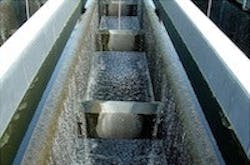Water Pollution Control Plant Addresses Nutrient Removal
Located in a commercial/residential neighborhood, the Arlington County Water Pollution Control Plant (WPCP) in South Arlington, Va., treats flows from nearly all of Arlington. In addition, nearly 20% of the plant’s flow comes from neighboring localities such as Alexandria, Fairfax County and Falls Church. Effluent from the plant is discharged into Four Mile Run to the south, which feeds into the Potomac River and, ultimately, the Chesapeake Bay.
With a growing population in the county’s residential and business communities putting a strain on the aging WPCP infrastructure and insufficient treatment capacity to handle wet weather flows that could increase nearly fourfold, Arlington County officials recognized the need to address the facility’s long-term challenges. The county board decided to proactively upgrade the plant's treatment process to provide "limit of technology" nutrient removal in advance of any requirements to do so. This would require upgrading the plant's biological nutrient removal (BNR) 8 mg/L total nitrogen (TN) capability to meet an anticipated TN limit of approximately 3 mg/L with a concurrent low total phosphorous limit of 0.18 mg/L. Virtually every process and structure was renovated, expanded or upgraded in the WPCP.
Upgrade
The project was executed in two phases. Phase one included building two pre-stressed concrete flow-equalization tanks with a combined capacity of 12 million gal, a 30,000-sq-ft filtration and disinfection facility equipped with 17 TETRA Denite deep bed denitrification filters, each 12 ft 6 in. x 72 ft 4 in. with a total surface area of 15,370 sq ft and two chlorine contact tanks. Phase two included three new 140-ft-diameter secondary clarifiers, two new advanced aeration tanks, a new pump station, preliminary treatment bypass facility, two mixed liquor distribution structures and a primary effluent channel. Additional equipment incorporated in the main contracts included two odor control scrubbers, two chemical feed facilities and upgrades to the bulk of the electrical distribution network. The total cost for the project was $568 million.
Pilot Testing the TETRA Denite Technology
Malcolm Pirnie engineers conducted pilot testing of two denitrification filter technologies to achieve total nitrogen effluent limits and removal of effluent total suspended solids to ensure low effluent phosphorus concentrations. The tests were conducted in side-by-side conditions under various flows and loads, testing performance at average and peak conditions and influent phosphorus concentrations. TETRA Denite, a deepbed denitrification filter technology from De Nora Water Technologies, was chosen to replace the WPCP’s existing filters.
The TETRA filtration system is a fixed-film biological denitrification process that also serves as a deep bed filtration system capable of removing oxidized nitrogen (NOx-N), total phosphorous (TP) and suspended solids (SS) to meet a high standard of effluent discharge. TETRA Denite is a single treatment solution, which addresses multiple wastewater treatment plant process needs by offering an economical, small footprint and virtually maintenance-free operation.
Fundamental to the TETRA Denite process is the specially sized and shaped granular media used in the fixed-film biological filters. The high solids loading capacity of the media is ideal for retaining biological solids produced by the denitrification process, and the powerful backwash of the Denite filter system removes these solids periodically. The surface area of the 2 to 3 mm-diameter sand particles is very large, providing 650 m2/m3 contact between the wastewater supply and the biomass. The media allows for heavy capture of solids—at least one lb of solids per sq ft of filter surface area before backwashing is required.
Full-Scale Operation
The Arlington County plant is now one of the first major effluent denitrification facilities achieving effluent TN < 3.0 mg/L and TP < 0.18 mg/L. Since June 2010, the plant has consistently achieved < 2.5 mg/L TN and <0.1 mg/L TP. This has been accomplished by not only replacing effluent filters with TETRA Denite but also modifying all upstream processes.
Because of the plant’s design and achievements Malcolm Pirnie won the Excellence in Environmental Engineering competition’s 2011 Grand Prize in Design. The competition is sponsored by the American Academy of Environmental Engineers.
